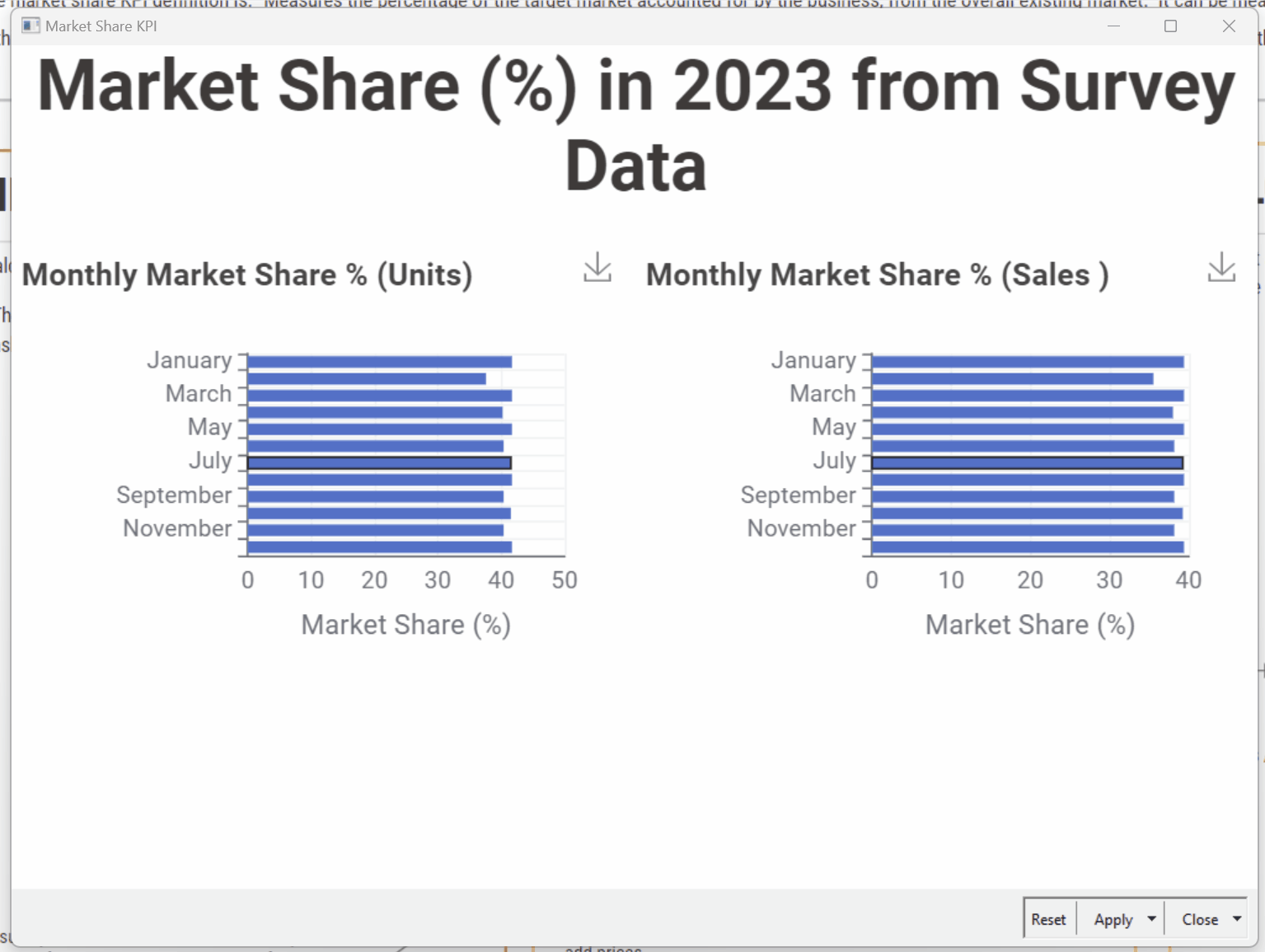This is part of a series of articles to show you solutions to common finance tasks related to financial planning, accounting, tax calculations, and auditing problems all implemented with the low-code KNIME Analytics Platform.
We continue our series of KPI that any CEO should be aware of. Today we discuss the Market Share KPI. The Market Share KPI quantifies the impact of a company within its industry.
If the maximum business potential market size is A and the company is able to sell to a market segment B, then its market share would be the ratio of B to A, expressed as a percentage.
A and B can be intended in measures of revenue (e.g. A is the total potential revenue and B is the actual revenue) or in terms of units - (e.g. A is the total potential units and B is the actual units sold by the company).
The KPI calculation changes slightly if we are dealing with a one-purchase scenario or a multiple-purchase scenario. A one-purchase scenario refers to all those goods that a customer purchases at most once in a year, like for example a car.
In this article we propose a solution for the calculation of the market share KPI for a one purchase scenario.
Task: Calculate Market Share KPI in a one-purchase scenario
Market Share KPI measures the percentage of the target market that a business accounts for within the overall market. There are two main methods to determine market share: by sales revenue or by volume of units sold.
By Sales Revenue
To calculate market share by sales revenue, divide your company’s sales by the total sales in the market and multiply by 100. This gives the percentage of the market that your company occupies.
By Volume of Units Sold
To calculate market share by volume, divide the number of units your company sold by the total number of units sold in the market and multiply by 100.
Estimating the Total Market Size
The challenge lies in estimating the total market size.
This estimation sometimes is available by external sources, for example the number of people on Earth in need of a specific medicine. Or the number of families in a region in need of a fridge.
Alternatively, this estimation can be derived from survey data where a sample population is queried, and the results are extrapolated to represent the entire market. The quality of the estimation lies in how representative the sample is.
Let’s take the example of cars in a given region. In a survey of 100 people (A), 10 people (B) bought the car produced by your company. In this case, the market share is 10%.
Alternatively, since we know the exact number of cars sold by the company in one year or in a month, we can extrapolate the number of possible car customers from the 100 respondents of the survey.
Also, if we know the price of each car reported in the survey, we can calculate the total market size in terms of revenue money.
Summarizing, there are three possible ways to approach the estimates of the data: via surveys, via company data and external sources for the market size, or via a mixture of the two.
The workflow: Market share KPI as units sold
Let’s limit the first workflow to a company selling only one product (prod A) at a 100$ price.
As Number of Units Sold from Survey Data
We read the results from a survey run over 1000 people where people were asked which kind of product (prod A, prod D, prod Y, prod X, prod Z, or none) they bought in 2023 and when.
Let’s create a report with the market share for the whole 2023 in the title and a bar chart reporting the progressive market shares owned by the different products on the market.
- First, we isolate the people who bought a product, any product. This is our market base.
- Then we count the number of people who bought a product (any product) in 2023 and the number of people who bought a specific product in 2023 (named “total market share” and “units” respectively).
- Then we calculate the Market Share KPI as “units” / “total market share (units)” * 100 for all products
- Finally, we display the result in a component with the market share of prod A as the title of the web page and with a bar chart or the market shares owned by the different products.
As Sales Revenues $ from Survey Data
A similar chart could be drawn also for the amount of sales $. We already know that prod A costs 100$. We just need to know all other products’ costs and then multiply the units sold by their corresponding price to obtain the total amount of sales for each product and therefore for the whole market.
The workflow does not change much, besides the addition of a file with the product prices and the calculation of the second KPI based on sales amounts.
As Number of Units Sold from Company Data
Surveys however can only take you that far. Surveys are expensive, might not be statistically representative, and might not describe the market in its entirety. Indeed, people do not like to take part in surveys and often their remembering might not be precise.
Let’s take our previous example to the next level and let’s try to design a workflow with a bar chart for monthly KPIs. In this case, the survey is not sufficient, since it does not provide data for many months of the year. Company sales data are more reliable and well documented. However, we cannot estimate the market size from the company’s product only.
In this case, to estimate the market size we could refer to external accredited sources. Alternatively, we could extrapolate the survey data to get an idea of the total market size. For example, if the survey says that 30 out of 100 respondents bought prod A, but we know from company data that actually 300 prod A were sold, we could say that the survey describes the total market as a factor of 100. If respondents were 100 and 80 bought a product, then the total market size would be 80 * 100 = 8000 possible customers. Let’s try this approach to calculate the Market Share KPI based on the company's data.
So, in addition to acquiring the survey data, this time we also query the company sales database (here represented by an Excel file) about all products “prod A” sold in 2023.
We then calculate the representation factor by the survey data vs the total market and we adjust the survey’s estimate of market size by the representation factor. The total market size is then divided by the 12 months of the year, to obtain the monthly market size.
We then calculate the monthly number of units sold and the sales revenues for prod A as available from the sales database.
We finally calculate and visualize the monthly market share KPI from the monthly number of units sold / sales revenues and the corresponding estimate of the market size.
Results: Explore monthly/yearly Market Share KPI
Either you use survey data or company data, we have shown you a way to calculate the Market Share KPI. In both cases, we estimated the market size from survey data; thus the KPi is as reliable as the survey data is statistically significant.
We have used two different visualizations for the final results.
From Survey Data a Progressive Bar Chart. Since survey data did not include all months of the year, we decided to visualize the market share KPI for the whole selected year, as a progressive bar chart for the different products.
From Company Data a Monthly Bar Chart. When we used the company sales data, the monthly information was available. Thus we went for a bar chart showing the monthly market share KPI for only the company’s product.

Notice the different usage of the bar charts and the different information available to us from the two applications.
Conclusions
In this article we have shown you an important KPI: the Market Share KPI. We have shown you what it is, how it is calculated, and how it can be implemented and visualized for a one-purchase scenario, from survey data or from company data, in terms of units sold and sales revenues.
In the next article, we would like to extend the implementation of this KPI to a multiple purchase scenario. Stay tuned!
Acknowledgements
This work has been based on an existing workflow by Paolo Tamagnini.
